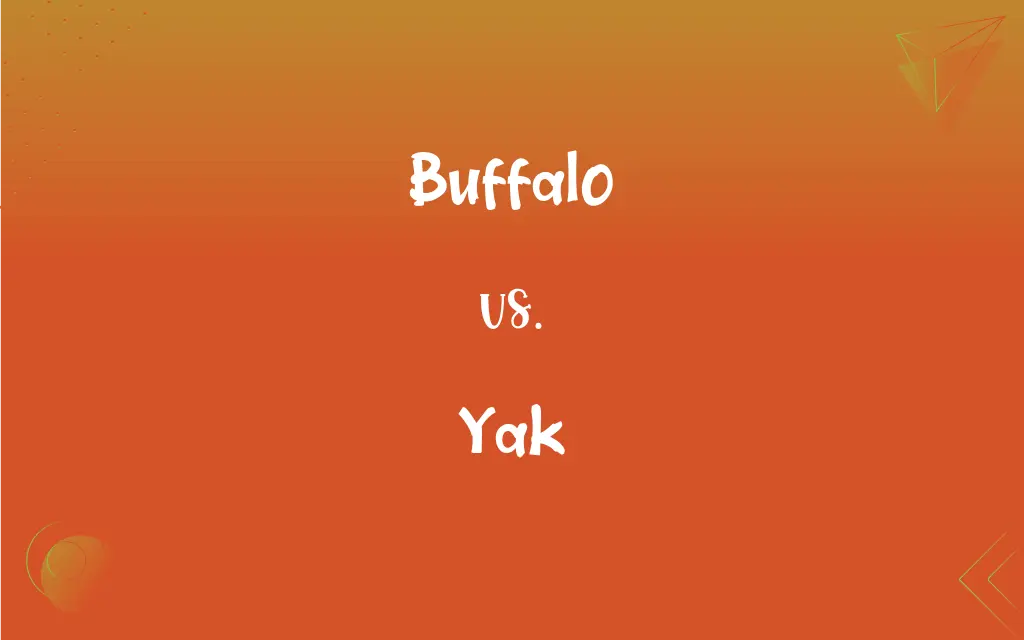Buffalo vs. Yak: What's the Difference?
Edited by Janet White || By Harlon Moss || Updated on November 6, 2023
A buffalo is a large bovine found in Africa and Asia; a yak is a long-haired bovine found in the Himalayas and Central Asia.

Key Differences
"Buffalo" refers to several species of large bovines including the African buffalo and the water buffalo from Asia. They are known for their horns and live in varied habitats such as savannas and swamps. "Yak," on the other hand, is a specific type of long-haired bovine native to the Himalayan region, known for its ability to withstand cold climates.
Buffaloes are widely domesticated for their meat and milk, particularly in Asia, where the water buffalo is prevalent. They have wide, sweeping horns and are associated with wet, marshy areas where they often wallow in the water. Yaks are adapted to high altitudes, with thick fur for insulation, and are also used for their meat and milk, as well as for carrying loads.
The "buffalo" can be a symbol of strength and is significant in various cultures, playing a role in agriculture and folklore. In contrast, the "yak" is integral to the lifestyle of Himalayan peoples, providing a source of wool, milk, and transportation. Yaks are less widespread than buffaloes and are rarely found outside their native habitats.
In physical characteristics, buffaloes have a more robust build with larger horns, and they lack the long hair of the yak. Yaks have smaller horns and a thick undercoat beneath their long hair, which protects them from the cold. Buffaloes are adapted to warmer climates and are generally larger in size compared to the typically smaller, but sturdier, yak.
While both "buffalo" and "yak" are bovines and part of the Bovidae family, they belong to different genera and have distinct adaptations that suit their environments. Buffaloes are more associated with farming and rural life in plains and deltas, whereas yaks are iconic in the mountainous regions of Asia, vital to the survival of the communities there.
ADVERTISEMENT
Comparison Chart
Habitat
Africa, Asia (savannas, swamps)
Himalayas, Central Asia (mountains)
Physical Appearance
Large body, wide horns, less hair
Smaller body, thick long hair, small horns
Domestication
Widely domesticated for meat and milk
Used for meat, milk, wool, and transport
Climate Adaptation
Adapted to warmer climates
Adapted to cold, high-altitude climates
Cultural Significance
Integral to agriculture in many cultures
Vital to Himalayan peoples' survival
ADVERTISEMENT
Buffalo and Yak Definitions
Buffalo
Specifically, the African buffalo, a member of the "big five" game.
The African buffalo is known for its unpredictable nature.
Yak
Domesticated for use as pack animals and for their meat and milk.
The villagers rely on yak milk for daily nutrition.
Buffalo
The water buffalo, an Asian species domesticated for farming.
Water buffaloes are essential for rice farming in Asia.
Yak
A long-haired bovine native to the Himalayan region of Asia.
Yaks can navigate the rough terrain of the Himalayas with ease.
Buffalo
A large bovine animal with horns, known for its strength.
The buffalo roamed the grasslands in herds.
Yak
Known for their thick woolly coats that protect them from cold.
Yak wool is used to make warm clothing for the harsh winters.
Buffalo
In North America, often used incorrectly to refer to the bison.
The buffalo once roamed North America in vast numbers.
Yak
A symbol of life at high altitudes in Central Asian cultures.
The yak is an iconic animal in Tibetan culture.
Buffalo
Can refer to Buffalo, a city in New York, United States.
She moved to Buffalo for its renowned architecture.
Yak
A term also used informally to mean talking at length.
They spent the evening yakked away about old times.
Buffalo
Any of several large African and Asian ruminant mammals of the family Bovidae, such as the water buffalo and the African buffalo.
Yak
A wild, shaggy-haired ox (Bos grunniens) of the mountains of central Asia.
Buffalo
The American bison (Bison bison).
Yak
A domesticated yak, used as a work animal or raised for meat and milk.
FAQs
What is the primary habitat of a buffalo?
Buffaloes primarily inhabit the grasslands and wetlands of Africa and Asia.
Can yaks survive in warm climates?
Yaks are adapted to cold climates and do not fare well in heat.
Are yaks domesticated for their fur?
Yes, yaks are valued for their thick fur, used for making warm clothing.
What is the difference between a bison and a buffalo?
Bison are a North American species with a hump and shaggier coat, while buffaloes are typically African or Asian without a hump.
What are buffaloes used for?
Buffaloes are used for their meat, milk, and as draft animals.
Where are yaks found?
Yaks are native to the Himalayan region and surrounding areas in Central Asia.
Are buffaloes and yaks the same species?
No, they are different species with distinct characteristics.
Do buffaloes have horns?
Yes, both African and Asian buffaloes have horns.
Are yaks used for transportation?
Yaks are often used as pack animals in mountainous regions.
How do buffaloes cool themselves?
Buffaloes often wallow in water or mud to regulate their body temperature.
Is yak milk consumed by humans?
Yes, yak milk is a staple in the diet of Himalayan peoples.
How well can yaks carry weight?
Yaks are sturdy and can carry heavy loads over difficult terrain.
Can you ride a buffalo?
While not common, it is possible to train some buffalo species for riding.
What is the significance of the buffalo in agriculture?
Buffaloes are especially important in Asian agriculture for plowing fields and other farming tasks.
Do buffaloes live in herds?
Yes, buffaloes typically live and travel in herds.
Do yaks have any predators?
Yaks do have predators, including wolves and snow leopards.
What products are made from yaks?
Yak products include milk, cheese, butter, wool, and meat.
What type of climate do yaks thrive in?
Yaks thrive in the cold, high-altitude climates of the Himalayas.
Are buffaloes dangerous?
Buffaloes can be unpredictable and dangerous, especially if threatened.
What is the population status of buffaloes?
Some buffalo species are numerous, while others, like the African buffalo, face conservation challenges.
About Author
Written by
Harlon MossHarlon is a seasoned quality moderator and accomplished content writer for Difference Wiki. An alumnus of the prestigious University of California, he earned his degree in Computer Science. Leveraging his academic background, Harlon brings a meticulous and informed perspective to his work, ensuring content accuracy and excellence.
Edited by
Janet WhiteJanet White has been an esteemed writer and blogger for Difference Wiki. Holding a Master's degree in Science and Medical Journalism from the prestigious Boston University, she has consistently demonstrated her expertise and passion for her field. When she's not immersed in her work, Janet relishes her time exercising, delving into a good book, and cherishing moments with friends and family.































































